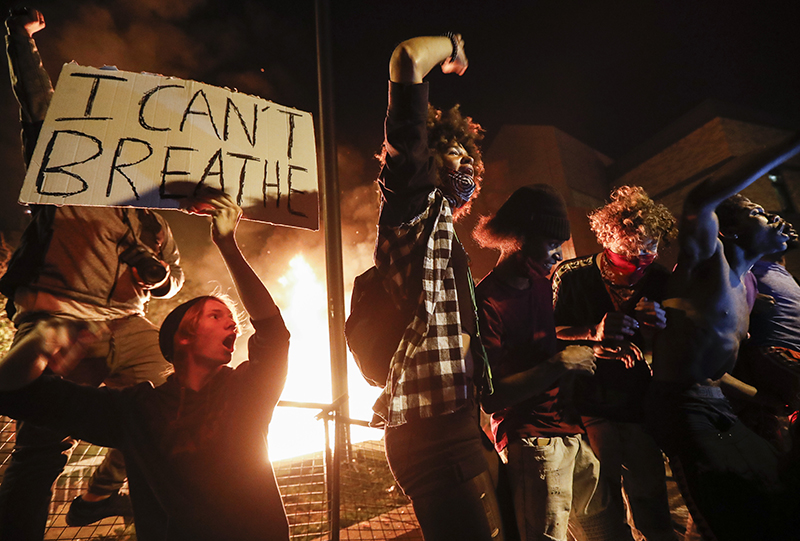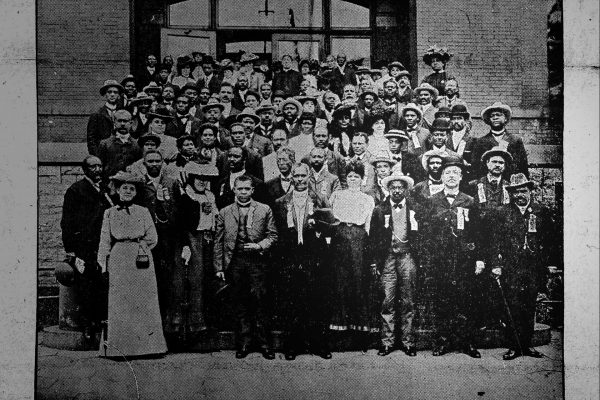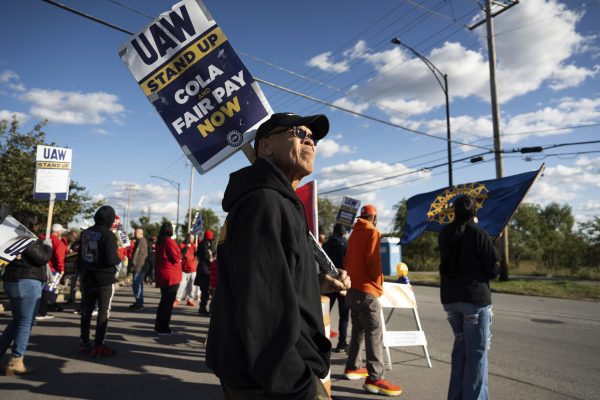On Monday, George Floyd, a black man in Minneapolis, was murdered by those sworn to protect and serve. As Floyd pleaded for his life, a police officer pressed his knee on Floyd’s neck until his body lay lifeless. We know the image; we have heard the pleas for help, the appeals to show mercy. His death mirrors the recent killings of so many unarmed black men. As in other instances, Floyd’s cries fell on deaf ears—the ears of the officer suffocating him and the three other officers who stood witness to the murder. His death is the latest in an extended history of lynching.
We don’t yet know if the United States is convulsing because it wishes to be something new and better, or is raging to remain something old and twisted.
A city now burns as rage and anger match the gravity of Floyd’s death. Last night, a CNN reporter was dragged off live television by police as he reported on the events, and Friday morning the president threatened on Twitter to send in the military to kill protesters. This is where we are: a nation exhausted, slouching (perhaps) toward collapse.
The anger and rage on display in Minneapolis is not only about police violence, however. It is taking place against a broad horizon of state violence, which among other things takes the form of utter disregard for the pain of black Americans. Amid the revelation that COVID-19 is disproportionately affecting the black community, we have watched as states make plans to reopen their economy and, so doing, ask that same community to sacrifice even more. Little attention has been given to the structural inequalities of our health care system and the ways it worsens the pandemic’s impact on black life. The coronavirus in black America is not merely the result of a lack of access to good health care, but it is also due to the way racial bias structures physician engagement with black people. Whether explicit or implicit, the failure to critically engage this problem, with care and concern, is of a piece with the nation’s habit of regularly reminding black people that their lives don’t matter.
This, of course, is further intensified by the recent memory of armed white protesters defying stay-at-home orders. As they flouted public health best practices, white protesters terrorized communities, forced at least one capitol to close, and threatened public officials. These uncaring armed assertions of personal sovereignty were met with little criticism and, in fact, found support from the president. For example, in response to the protests in Michigan, he tweeted: “These are very good people, but they are angry. They want their lives back again, safely!”
In contrast, responding to Minneapolis protesters, and using the words of the segregationist George Wallace, he wrote this of the military response he would order: “when the looting starts, the shooting starts.” The invocation of looting always functions as a justification for intensifying harm against black people and obscuring the initial events that sparked the entire uprising. That is to say, by focusing on the violence of protests, we suspend criticism of the terror that white Americans daily visit upon black bodies, usually in response to some entirely imagined danger: “He didn’t respond to the police orders,” “I felt threatened by him,” and so on. We also blind ourselves to the logic of protests—their quest to rightly disturb the peace in response to injustice—and how much that logic is aimed precisely at producing uncertainty. The uncertainty of protest—both its peaceful manifestation and its chaotic and destructive forms—sits at the heart of its transformative potential.
Protesters express a refusal to continue the status quo—the ease with which black life is extinguished.
In recent weeks, we’ve faced so many awful revelations: police brutality, the COVID-19 pandemic, the armed claims of individual sovereignty, and a president who plays to the darkest features of human nature and U.S. culture. All reveal the inability of our social and political culture to provide for the common good, and seem to suggest that collapse is close at hand. Indeed, the resources of our political and social culture—what we call democracy—can be exhausted, or at least appear to be exhausted. At that moment, events point to something else on the horizon. The veneer of peace and order disappears. Protesters express a refusal to continue the status quo—the ease with which black life is extinguished—but it is not clear what is to come. The protesters don’t know, and the president doesn’t know (although he pretends to have control).
What opens—what is beginning right now in this country—is a profoundly unsettled space. Something might emerge, something better than what we have, something more satisfying, and more caring. We’ve seen the rays of hope in the solidarity produced by Black Lives Matter and the efficacy of local legislative agitation. But authoritarianism could also fill the void—the president is already singing that song. It is the siren song that has empowered murderous neo-Nazis and militias, whose vision matches the president’s determination to make the United States the domain of white manhood.
The danger is that we just don’t know if the United States is convulsing because it wishes to be something new and better, or is raging to remain something old and twisted. We all should be worried and afraid, but not of the protesters. We should be concerned and fearful that the country may not have the courage to imagine differently, that it may not be able to separate the meaning of freedom from the taking of black lives. How ironic: the taking of black life built the country and that very same logic may bring the country to its knees.








